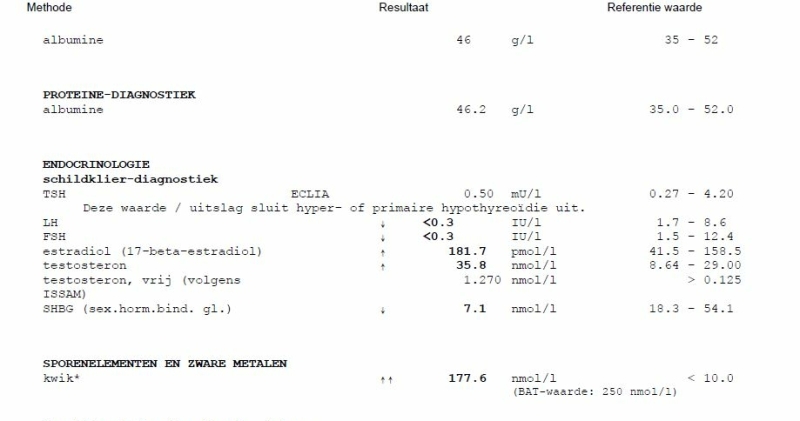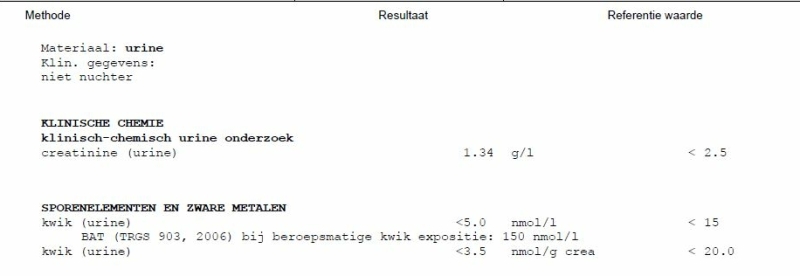That you can get mercury poisoning from working in factories is something we have measured many times in blood value tests. For example, we did see elevated values in people who used to work in factories where thermometers were made. But is eating fish from the sea also dangerous? When is eating fish unhealthy?
How much fish can you eat?
The nutrition center's advice is as follows: "Fish is good for health. Fish fatty acids are good for your heart and blood vessels. Therefore, the advice is to eat fish once a week. Preferably oily fish, such as mackerel, herring, sardines or salmon."
So eating fish a few times a week is no problem at all. Until people eat more fish, especially the large fish species.
Avoid too much consumption of predatory fish such as shark, swordfish, king mackerel and canned tuna because of the accumulation of mercury in these fish species. Pregnant women and young children should be careful with these fish species.
If you really eat a lot of fish from the sea every day, you will get too much mercury in your blood. This shows again how polluted our environment is.
Risk for Pescotarians
Bodybuilders need to take in a lot of protein to help build muscle.
This is a result of the blood test Jordy tried to get his protein from fish instead of chicken, cottage cheese and eggs because he is a pescotarian.

If you are a Pescotarian you do not eat meat, eggs and dairy, but you do eat fish. There are many reasons to become a pescotarian. The most important reason is that it is a lot healthier. With the vegetarian diet one is not allowed to eat meat and fish. Because pescotarians do eat fish, they often don't get enough nutrients. Besides that many pescotarians choose this diet because they think cattle is treated badly, while this is less the case with fish. They often choose to eat only wild fish and not farmed fish.
But it is precisely the wild fish that can cause you to accumulate too much mercury in your body?
How does mercury poisoning occur?
You can be exposed to mercury in different ways:
- Consumption of fish is by far the most significant source of mercury exposure, although plants and livestock may also contain mercury
- By breathing polluted air.
- By eating corn syrup which is high in fructose.
- Due to the release of mercury vapor from mercury amalgam in dental fillings.
- By improper use of mercury or by disposing of mercury or mercury-containing objects as waste, such as broken barometers, or old fluorescent and energy-saving bulbs.
Artificial sources like coal burners emit about half of the mercury in the air, the other half comes from natural sources like volcanoes.
About 2/3 of man-made mercury comes from combustion in power plants, especially coal (US, Australia, China). Other man-made sources include: waste released during the extraction of gold from ore, cement production, waste disposal, crematoria, sodium hydroxide, cast iron and steel production, mercury production, mostly for batteries, and biomass burning.
Mercury and mercury compounds are widely used in chemical laboratories, hospitals, dental clinics, and factories that produce fluorescent and energy-saving light bulbs, batteries, and explosives.
When is mercury poisoning?
Diagnosis of mercury poisoning means that you have to measure over a period of time to see if there is a chronic poisoning. Mercury concentrations in the blood should be lower than 10 nmol/l, but by eating a lot of fish a value of more than 200 nmol/l is reached.
On the lab report there is also a BAT value, which is the value that applies to people who work in factories where this substance is used, a maximum value of 250 nmol/l applies.
For example, if you are undergoing chelation therapy to detoxify, it is not useful to measure mercury in the urine, because by excreting the heavy metals, it will actually be elevated by the treatment.
Fish is healthy!
The Dutch eat an average of 16 grams of fish per day. Only one third reaches the recommendation to eat fish once a week. Compared to meat, fish contains more unsaturated fat. The exact composition of the fat differs per fish species. Part of the unsaturated fat consists of the fish fatty acids DHA and EPA. Eating fish is especially important because of these fish fatty acids. There are strong indications that eating fish is associated with a lower risk of cardiovascular disease. For example, eating fish 5 times a week compared to less than once a month is associated with an approximately 20% lower risk of certain heart diseases. But even in less extreme cases, eating fish provides a health benefit: eating fish at least once a week compared to less than once a month is associated with a 10% lower risk of stroke.
Most fish (and seafood) is rich in vitamin B12 and the minerals iodine, phosphorus and selenium. It is a source of vitamin B6. Fish naturally contains protein and fat. Fatty fish is also rich in vitamins D and B2 and contains vitamin A. Fish liver is rich in vitamin A. Fish contains iron, but less than meat because it contains less blood.
The following result is good, the result of mercury in urine in relation to creatinine may be 20 and there is a value of less than 3.5 measured. The bat value of mercury in professional blood tests may be up to 150 nmol / l.

Allergy
Fish contains proteins that can cause allergic reactions. The European Union has therefore decided that fish is a food allergen that can cause hypersensitivity reactions and that this must be stated on the label. Fish allergy is something you notice immediately, you don't even have to test for it because the reaction is very dangerous and acute. It is also possible that your body just can't digest fish very well, this is called food intolerance.
If that is the case you can test with the whatmagiketen blood test
Fish can also become infected with pathogens
For example, listeria or salmonella. These cannot be seen with the naked eye, nor can you taste or smell them. Raw fish can also contain the parasite herring worm. When heated, pathogens are killed.
Harmful substances
Due to environmental pollution, other harmful substances may also occur in fish. Such as other heavy metals, dioxins, PCBs or pesticide residues. Predatory fish are most affected by pollution. This is especially true for large predatory fish, such as sharks and swordfish. Fish that only eat plants or plankton are less polluted. Fatty fish species are also more polluted than lean ones, because harmful substances are stored in the fat. In addition, the habitat plays a role. For example, fish from European waters are more polluted than fish from the Pacific Ocean. Certain Dutch waters contain more dioxin than is good for you. For these waters there is a ban on catching wild eel or wolf crab. It is important to be careful when eating home-caught fish as the water may be polluted. Farmed fish may also contain harmful substances. This is especially true if it is fed with fish meal and fish oil.
What can you get from too much mercury?
Consuming foods containing mercury is the most common cause of mercury poisoning. Mercury poisoning can cause serious symptoms and put the body at unnecessary risk. Mercury is a naturally occurring metal found in many everyday products, albeit in small amounts. Limited exposure is safe but an accumulation of mercury can be very dangerous.
Mercury is a liquid at room temperature and evaporates readily in the surrounding air. It is often a by-product of industrial processes, such as burning coal for energy. Vaporized mercury can end up in rain, soil and water, where it poses a risk to plants, animals and humans.
Swallowing or coming into contact with too much mercury can cause symptoms of mercury poisoning.
symptoms of mercury poisoning
Mercury can affect the nervous system, leading to neurological symptoms such as:
- nervousness or anxiety
- irritability or mood swings
- numb feeling
- memory problems
- depression
- physical vibrations
The more mercury in your body, the more likely you are to experience symptoms. These symptoms depend on a person's age and level of exposure. Adults with mercury poisoning may experience symptoms such as:
- muscle weakness
- metallic taste in the mouth
- nausea and vomiting
- lack of motor skills or feeling uncoordinated
- inability to feel in the hands, face or other areas
- changes in vision, hearing or speech
- trouble breathing
- difficulty in walking or standing upright
Mercury can also affect a child's early development. Children with mercury poisoning may show symptoms such as:
- reduced motor skills
- problems with thinking or problem solving
- problems with learning to speak or understand language
- hand-eye coordination problems
- are physically unaware of their surroundings
Mercury poisoning tends to develop slowly over time if a person comes into contact with mercury frequently. In some cases, mercury poisoning occurs quickly and is associated with a specific incident.
Anyone experiencing sudden symptoms of mercury poisoning should call a doctor or poison control.
High levels of mercury in the blood can cause long-term neurological damage. These effects may be more pronounced in children who are still developing. A study in the Journal of Preventive Medicine and Public Health noted that many cases of mercury poisoning have resulted in long-term nerve damage, which can lead to:
- intelligence disorders and low IQ
- slow reflexes
- damaged motoric system
- paralysis
- numb feeling
- problems with memory and concentration
- symptoms of ADHD
- reproductive effects
Mercury poisoning also poses a risk to the reproductive system. It can cause a reduced sperm count or reduced fertility and can also cause problems with the fetus.
Possible effects of mercury poisoning include malformation and decreased fetal survival rate, and decreased growth and size of the newborn at birth.
Cardiovascular risks
Mercury helps promote the accumulation of free radicals in the body, putting cells at risk of damage. This can lead to an increased risk of heart problems, including heart attack and coronary artery disease.
Causes of mercury poisoning
The most common cause of mercury poisoning is eating seafood, but people can get mercury poisoning from industrial processing, thermometers and blood pressure machines, dental work and old paint.
Eating seafood contaminated with mercury is one of the most common ways people accumulate mercury in their bodies. The mercury in seafood is a highly toxic form of the metal methylmercury, which is created when mercury dissolves in water.
Methylmercury can be taken up from the water by all marine animals, but also passes through the food chain.
Small marine animals, such as shrimp, often ingest methylmercury and are then eaten by other fish. These fish now contain more methyl mercury than the original shrimp.
This process continues up the food chain, so a large fish may contain much more mercury than the fish it ate. However, this does not necessarily make it better to eat smaller fish. It is always essential for a person to check the source of their seafood to avoid contaminated fish and shellfish.
People concerned about their mercury exposure may want to limit their intake of seafood, especially fish high on the food chain, such as swordfish, shark, albacore, pike, zander and perch.
Pregnant or breastfeeding women may want to avoid or limit their intake of fish and shellfish, as the mercury they contain can pass through the umbilical cord or breast milk to the fetus or child.
Dental Fillings
Amalgam fillings, commonly called silver fillings, contain about 40 to 50 percent mercury. Amalgam fillings are no longer used today because there are newer and safer alternatives.
Old fillings can increase the risk of mercury exposure. Some people choose to replace their amalgam fillings to reduce their long-term exposure to mercury.
Other causes
Mercury poisoning may also be due to direct or environmental exposure. Exposure to mercury can come from one or more of the following sources:
- mining for gold
- exposure to some types of jewellery
- exposure to older paints
- some vaccinations
- contact with a broken fever thermometer or an older home thermometer
- toxic air in areas close to plants which produce mercury as a by-product, such as coal-fired power stations
- Some skin care products may also be contaminated with mercury, although this is unusual.
Treatment
Treatment for mercury poisoning includes eliminating all exposure to the metal. Doctors will recommend that the person not consume seafood that contains mercury.
If mercury poisoning is related to a person's workplace or environmental exposure, doctors may suggest that the person change their environment to reduce their exposure, or that the workplace implement new safety measures.
Mercury poisoning can cause some long-term side effects, which will be treated or managed individually.
Chelation Therapy
Certain types of severe mercury poisoning cases may require chelation therapy. This is the process of removing mercury from the organs so that the body can get rid of it.
The drugs used in chelation therapy bind to heavy metals in the bloodstream and are then excreted through the urine. Chelation therapy has its own risks and side effects, so it is crucial to use the medication only when necessary.
It is essential to consult a doctor in case of mercury poisoning
If you suspect you have a heavy metal load, ask your naturopathic doctor, natural dietician or organic dentist for further advice. He or she can test you for a heavy metal load and determine your detoxification capacity.
In addition, he or she can advise what foods and supplements you can take to support your body in getting rid of heavy metals and protect you from their harmful effects.
Want to know about your mercury levels?
Then do the test that measures mercury in your blood:
https://www.bloodtesting.nl/kwik-in-bloed-kwikvergiftiging.html
or in the urine:
https://www.bloodtesting.nl/kwik-in-urine-lekkende-amalgaamvullingen.html

